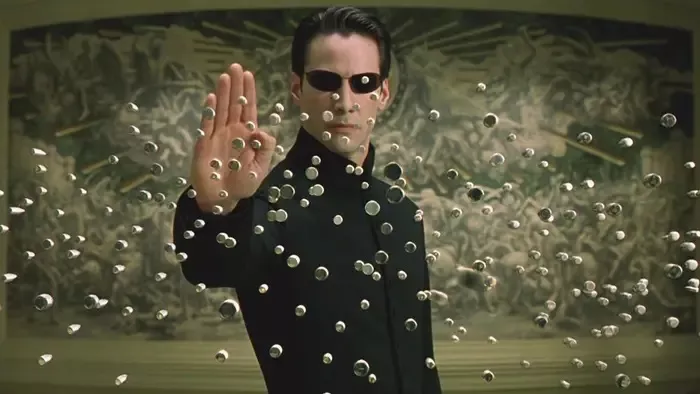The year was 1999 when “The Matrix” hit the silver screen, instantly captivating audiences worldwide with its groundbreaking visuals, philosophical depth, and innovative storytelling. Over two decades later, the film continues to hold a prominent place in popular culture, inspiring countless discussions, academic analyses, and even fashion trends. But why is the movie “The Matrix” so famous? Let’s delve into the multifaceted aspects that contributed to its enduring fame.
Revolutionary Visual Effects and Cinematography
One of the most striking elements of “The Matrix” is its revolutionary visual effects and cinematography. Directed by the Wachowskis, the film introduced audiences to groundbreaking techniques that had never been seen before. From the iconic bullet-dodging scene to the mesmerizing “bullet time” effect, the film pushed the boundaries of what was possible in filmmaking at the time. The seamless integration of live-action sequences with computer-generated imagery created a visually stunning experience that left viewers in awe.
The Matrix’s unique visual style, characterized by its green tint and futuristic aesthetic, became instantly recognizable and served as a benchmark for science fiction films that followed. The film’s innovative use of technology not only set a new standard for visual effects but also played a crucial role in immersing audiences in the dystopian world of the Matrix.
Complex Philosophical Themes
Beneath its action-packed surface, “The Matrix” delves into complex philosophical themes that invite viewers to question the nature of reality, free will, and the role of technology in society. Drawing inspiration from various philosophical and religious traditions, the film explores existential questions that have fascinated thinkers for centuries.
At the heart of “The Matrix” lies the concept of the simulated reality, where humans are unknowingly trapped in a computer-generated world while their bodies are used as a power source by artificial intelligence. This allegory for modern society’s dependence on technology and the quest for true knowledge resonated deeply with audiences, sparking discussions about the nature of perception and the search for ultimate truth.
Moreover, the film’s exploration of the “red pill” versus “blue pill” dilemma became a cultural touchstone, symbolizing the choice between embracing harsh realities or remaining in blissful ignorance. This philosophical underpinning added layers of depth to the narrative, elevating “The Matrix” from a mere action film to a thought-provoking meditation on the human condition.
See Also: Why is the movie Shutter Island a masterpiece?
Iconic Characters and Performances
Another factor contributing to the fame of “The Matrix” is its iconic characters and memorable performances. Keanu Reeves’s portrayal of the enigmatic protagonist, Neo, resonated with audiences, establishing him as an action star and earning him widespread acclaim. Reeves brought a sense of vulnerability and determination to the role, making Neo a relatable and compelling hero for viewers.
Alongside Reeves, Laurence Fishburne’s portrayal of the wise and stoic Morpheus left a lasting impression on audiences. Fishburne’s commanding presence and gravitas added depth to the character, elevating Morpheus to the status of a mentor figure and cultural icon. Additionally, Carrie-Anne Moss’s portrayal of the fierce and independent Trinity broke stereotypes of female characters in action films, earning praise for her portrayal of a strong and capable heroine.
The chemistry between the main cast members, combined with their dynamic performances, helped to humanize the characters and drew audiences into the world of “The Matrix.” Whether it was the camaraderie between Neo, Morpheus, and Trinity or the antagonistic relationship with the enigmatic Agent Smith, the characters and their interactions contributed to the film’s enduring popularity.
Innovative Action Sequences
One of the defining features of “The Matrix” is its innovative and adrenaline-pumping action sequences. Choreographed by renowned martial arts choreographer Yuen Woo-ping, the film’s fight scenes revolutionized the genre and set a new standard for on-screen combat.
From the gravity-defying kung fu battles to the intense gunfights, each action sequence in “The Matrix” is meticulously crafted and executed with precision. The use of wirework and martial arts techniques, combined with the film’s groundbreaking visual effects, created a sense of spectacle that left audiences breathless.
Moreover, the action sequences served a narrative purpose, advancing the plot and character development while showcasing the capabilities of the characters within the Matrix. Whether it was Neo’s training with Morpheus in the construct or the climactic showdown with Agent Smith in the subway, each fight scene contributed to the overall excitement and tension of the film.
Cultural Impact and Legacy
Beyond its initial release, “The Matrix” has left an indelible mark on popular culture, influencing a wide range of media and spawning a franchise that includes sequels, spin-offs, and even video games. The film’s iconic imagery, memorable quotes, and philosophical themes have permeated various aspects of society, from fashion and music to politics and technology.
The concept of the Matrix itself has become a metaphor for the illusions and systems of control that shape our lives, inspiring discussions about surveillance, artificial intelligence, and the nature of reality. The film’s legacy continues to resonate with new generations of viewers, cementing its status as a cultural phenomenon that transcends its original release.
In Conclusion
“The Matrix” remains famous for a multitude of reasons, from its revolutionary visual effects and philosophical depth to its iconic characters and innovative action sequences. As a groundbreaking work of science fiction cinema, the film continues to captivate audiences and spark discussions about the nature of reality and the human condition. With its enduring legacy and cultural impact, “The Matrix” stands as a testament to the power of storytelling and the enduring appeal of cinematic mastery.























